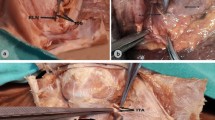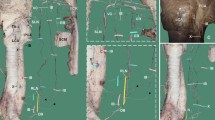Summary
Forty three specimens—(24 male and 19 females)—31 from dissection room, 4 from post-mortem and 8 foetuses were specially dissected.
The study shows that the recurrent laryngeal nerve divides invariably outside the larynx but in every case the anterior branch gives off the muscular branches after entering the larynx at a point above the level of the posterior aspect of the joint between the inferior cornu of the thyroid cartilage and the cricoid cartilage. The posterior branch is distributed to the mucous membrane.
The recurrent laryngeal nerve was more often superficial to the inferior thyroid artery on the right side and deep on the left side, in males; but in females it was superficial on both sides oftener. This difference in the relation of the nerve and artery in the sexes has not been mentioned and requires further investigation.
In none of the dissections on the 43 specimens did the recurrent laryngeal nerve pass through the thyroid gland. The nerve was always outside the sheath of the gland.
Similar content being viewed by others
References
Armstrong, W. G., and J. W. Hinton. (1951): Multiple division of the recurrent laryngeal nerve—anatomic study. Arch. Surg. 62, 532–539.
Berlin, D. D., and F. H. Lahey. (1929): Dissections of the recurrent and superior laryngeal nerves. Relation of recurrent laryngeal nerve to inferior thyroid artery and relation of superior to abductor paralysis. Surg., Gynec. and Obst. 49, 102–104.
Cunningham’s Text Book of Anatomy. (1951) : 9th edition, edited by J. C. Brash. Oxford University Press, London.
Dilworth, T. F. M. (1921): The nerves of the human larynx, J. Anat. 56, 48–52.
Gray’s Anatomy, Descriptive and applied. (1950) : 30th edition, edited by T. B. Johnstone and J. Whillis. Longmans, Green & Co., London.
King, B. T. and R. L. Gregg. (1948): Anatomic reason for various behaviours of paralysed vocal cords. Ann. Otol. Rhin. and Laryng. 57, 925–944.
Meurman, O. M. (1950): Theories of vocal cord paralysis, Acta oto-laryng. 38. 460–472.
Morris’ Human Anatomy. (1953) : 11th edition, edited by J. Parsons Schaefer. The Blakiston Co., New York.
Morrison, L. F. (1952): Recurrent laryngeal nerve paralysis—revised conception based on a dissection of 100 cadavers. Ann. Otol. Rhin. and Laryng. 61. 567–592.
Sunderland, S. and W. E. Swaney. (1952): Intraneural topography of the recurrent laryngeal nerve. Anat. Rec. 114, 411–426.
Williams, A. F. (1951): The nerve supply of the laryngeal muscles. J. Laryng. and Otol. 65, 343–348.
Williams, A. F. (1954): Recurrent laryngeal nerve and the thyroid gland. J. Laryng. and Otol. 68, 719–725.
Author information
Authors and Affiliations
Rights and permissions
About this article
Cite this article
Ramaswamy, S. The recurrent laryngeal nerve. Indian J Otolaryngol 11, 104–112 (1959). https://doi.org/10.1007/BF03047711
Issue Date:
DOI: https://doi.org/10.1007/BF03047711




